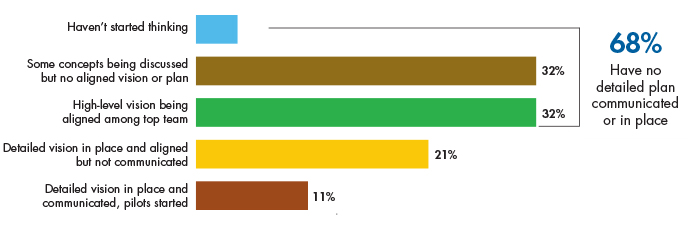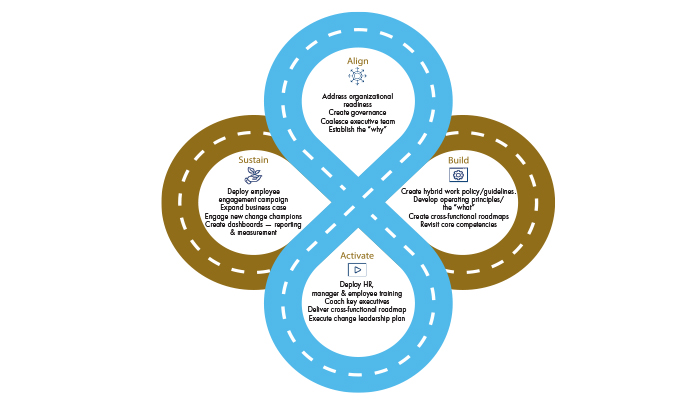Hybrid Work
Time to Hit the Reset Button

Hybrid Work
Time to Hit the Reset Button


How has the financial services industry weathered the pandemic? Over the past two years, we have invented new products, zeroed in on ways to better serve customers and alleviate pain points, and hit the reset button on workforce management that supports both the home office and sales agents.
Reinventing a workplace with a well-thought-out strategy is critical to maintaining productivity and retention in today’s workforce — as well as the next generation of advisors and customers — especially during these days of the “Great Resignation.”
Put simply, operating like “the good old days” will not work. We need to innovate. We need to evolve. We need to think beyond our current geographies to recruit the best talent.
It’s time to raise the bar on how we optimize technology to create new bonds, build rapport, and convey human touch.
So here are three fresh opportunities to consider: take advantage of existing business models, proclaim a new way forward for talent management strategies, and rethink and optimize real estate footprints.
Today’s environment represents an important inflection point, as it became clear during the pandemic that outmoded aspects of our industry can pose a threat to business success. The good news is, there are specific roles (like actuaries, call centers, IT, and sales) that lend themselves perfectly to remote or hybrid activity.
Much of financial services work relies on managing relationships. For advisors in particular, being accessible in various ways — in person or virtually — can dramatically increase productivity. This business is all about people and relationships. It’s time to raise the bar on how we optimize technology to create new bonds, build rapport, and convey human touch. We need to make people feel respected and appreciated. For a true win-win, do small things that make a big difference — sending texts or thank you notes can really brighten someone’s day.
People need help to visualize their future work opportunities — and that falls on executive leadership. No one wants to feel stuck, not knowing if their job location or ability to work remotely is on the chopping block.
Everyone craves connections at the office. Talent expects to hear their leaders share the way forward on hybrid.
Recent research shows that while organizations are clear that their work models will be hybrid, most do not have a detailed plan (Figure 1). Nearly a third of them say their organizations lack alignment with a high-level vision among the top team. Another third have a more detailed vision in place, but only 1 in 10 have begun communicating and piloting that vision.
Employees deserve to know your intentions, and you can’t afford to wait. Even if the commitment to hybrid work is just in the early stages, you need clear communication. At a minimum, you need to give people a glimpse of your future workforce strategy.
Figure 1
Post-Pandemic Work Will Be Hybrid; After That, Details Get Hazy

Source: What Executives Are Saying About the Future of Hybrid Work, McKinsey & Company, May 17, 2021.
For the last two years, most employees did not have a regular office experience. It is imperative to create an office atmosphere where people want to work. There are opportunities to make small, modest, or grand changes to the configuration, footprint, technology, protocols, and amenities.
This is an opportune time for leaders to implement other long-desired changes as part of a return-to-office strategy. For example, will overcrowded departments return to a more open space or hoteling opportunity? Could companies limit the number of copiers/printers to encourage less reliance on paper? Consider how to “democratize space,” changing the rulebook on who gets space based on need rather than level. Introduce Slack or other collaborative tools to bring your people together to work and innovate irrespective of location.
With regard to benefits and amenities, revisit your policies on commuter/parking benefits, lunches, coffee, gym memberships, and other perks. Paying or subsidizing them for a period of time could be part of what gets your people re-energized and excited to return to the office as part of your hybrid strategy. Be clear on which tasks and activities are best accomplished in an office environment. Remember, employees have been out of the office for an extended period and have established new habits and norms.
You can use real estate to pull employees back to the office while also shaving off expense lines by knowing exactly how space is currently used and where talent will reside, now and in the future. In 2022, keep close tabs on how your people have adjusted to remote or hybrid work and then fine-tune your real estate footprint as part of that strategy.
Now is the time to look at space strategically, from a cost and people perspective. Craft a well-articulated value proposition. Let everyone know what the office now repre- sents and back that up with plans and incentives.
One of the companies we have consulted with for many years was ahead of the pack when COVID-19 hit. They slowly and methodically had introduced the flex work concept to their associates as a business continuity measure. Collectively, we helped to evolve the business case solving for talent, wellness, and real estate, following FlexPaths’ four-step approach to sustaining a hybrid workforce (Figure 2):
Figure 2
Realize & Sustain a Hybrid Workforce Model

Source: FlexPaths, LLC, 2021.
The result was a flex model with a combination of in-office, blended, and remote work. The pandemic spawned some new points of view about how and where employees work. Today, the large-scale investment and longer-term commitment that this firm made in real estate is now evolving, giving the company pause in how to bring together their pre-pandemic point of view and the right model that supports the newer realities of a post-pandemic world.
For another company, our team provided ongoing support with less structure and rigor. This included discussions with executive leadership to inform and align on language and positioning, flex work training for leaders, and policy recommendations. They, too, had a new progressive footprint with a mostly in-office presence. When the pandemic hit, the company allowed their people to make the choice: in office, hybrid, or remote. To enable that strategy, employees received a steady stream of transparent communications designed to promote an evolving corporate culture.
While there is no guarantee that hybrid will be a “forever” reality, companies that actively solve for today’s workplace realities — in alignment with their talent’s needs — have a better chance of success.